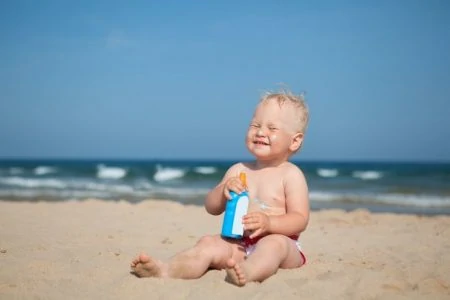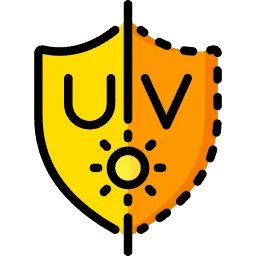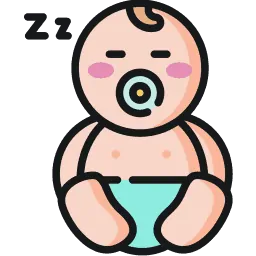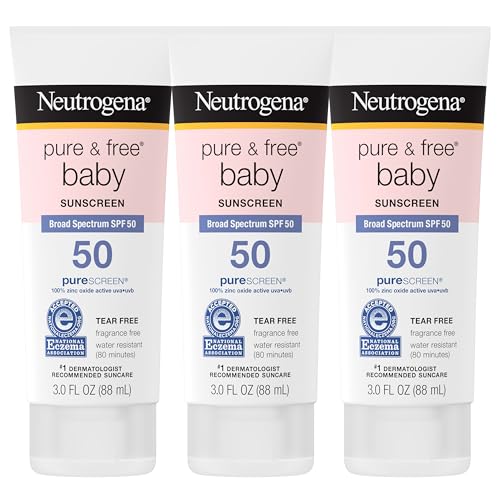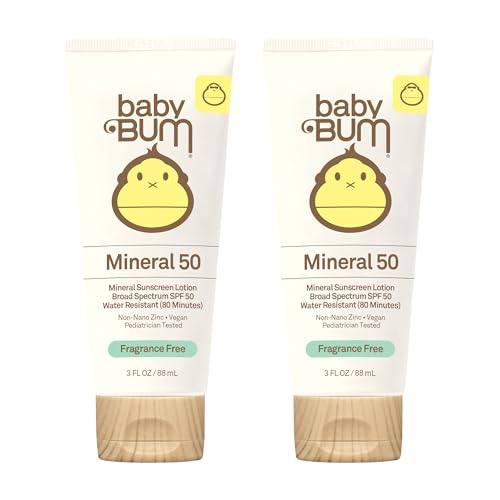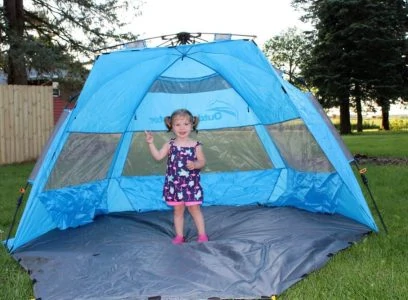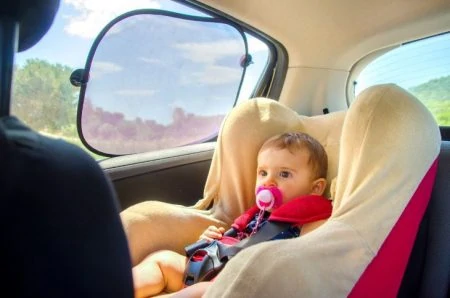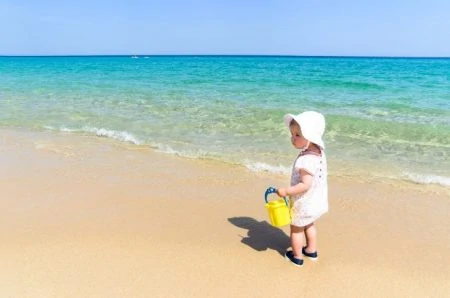We all love seeing our kids play outside, but those UV rays are sneaky. Even a little sun exposure can damage your baby’s delicate skin. Sunscreen is your best defense against burns and long-term issues, but the options on the shelf can be overwhelming.
We dove into the science and safety guidelines to bring you this clear guide. We also analyzed ingredients and textures to bring you our top picks for the best baby sunscreens on the market so you can enjoy the sunshine worry-free.
- Formulated for eczema-prone skin
- Doesn’t feel thick or oily
- Broad-spectrum protection
- Suitable size for air travel
- No harmful chemicals
- No sticky feeling
- Certified organic and safe
- Contains only 11 ingredients
- Fragrance free
- Convenient spray application
- Water-resistant
- Won’t sting child’s eyes
- BPA-free
- Broad-spectrum protection
- Paraben and fragrance-free
- Developed by dermatologists
- Water/sweat resistant
- Offers barrier protection
- 100% natural formula
- Biodegradable plastic bottle
- 40 minutes water & sweat resistant
- Long-lasting and hypoallergenic
- Hydrating but non-greasy
- Tested by dermatologists
Why Your Baby Needs Sunscreen
The sun emits ultraviolet light that causes burns and contributes to skin cancer later in life. Children are particularly vulnerable. In fact, just one blistering sunburn during childhood can double the risk of developing melanoma as an adult (1).
There are two main types of UV rays you need to worry about:
- UVA Rays: These penetrate deep into the skin (the dermis) and damage cell DNA.
- UVB Rays: These are the primary cause of sunburns and play a key role in skin cancer development (2).
Sunscreen, specifically broad-spectrum formulas, acts as a shield. It stops these rays from absorbing into your baby’s skin.
You should protect your child every time they go outdoors. UV rays are present regardless of the temperature or cloud cover (3). Even in winter, when the sun feels weaker, those damaging rays are still hitting exposed skin.
What SPF is Best for Babies?
SPF stands for Sun Protection Factor. It measures how well the product blocks UVB rays. While the math can get technical, the real-world application varies based on your location and the time of day (4).
Most experts agree on the following guidelines regarding SPF:
- Minimum SPF 15: This is the baseline recommendation.
- SPF 30 is the Sweet Spot: While higher numbers offer more protection, it isn’t exponential. SPF 30 blocks about 97% of UVB rays, while SPF 50 blocks about 98%. Going above 50 offers negligible extra benefits (5).
Don’t let a high number give you a false sense of security. No sunscreen blocks 100% of the sun. The golden rule is to apply it liberally 15 to 30 minutes before going outside and reapply every two hours, no matter what the bottle says.
Mineral vs. Chemical Sunscreen
This is the biggest choice you will make when shopping. Sunscreens generally fall into two categories:
- Chemical Sunscreens: These are “traditional” lotions that soak into the skin. They work like a sponge, absorbing UV rays and converting them into heat to prevent damage.
- Mineral (Physical) Sunscreens: These sit on top of the skin like a shield. They use ingredients like zinc oxide or titanium dioxide to reflect and scatter UV rays.
Mineral options are widely considered the safest choice for babies. They are not absorbed into the bloodstream and are less likely to irritate sensitive skin. The downside is that they are thicker and can leave a white cast, making your baby look a bit like a ghost.
Once you pick a type, you have to choose a format. Here is how the different application methods stack up:
- Lotions and Creams: These provide the best coverage because you have to physically rub them in, ensuring you don’t miss a spot.
- Sticks: These are fantastic for faces. They won’t drip into eyes, and they are easy to toss in a diaper bag for quick touch-ups on noses and ears.
- Sprays: These are convenient but risky. Inhaling the mist is dangerous for little lungs. If you must use a spray, spray it into your hands first and then rub it onto your child’s skin.
How To Choose a Sunscreen for Baby
When hunting for the perfect bottle, keep these criteria in mind:
Product Reviews
We analyzed ingredients, texture, and staying power to find the top 9 safe and effective formulas for your little one.
Neutrogena Pure & Free Baby Sunscreen
Best All-Round Sunscreen for Babies
If you want a sunscreen that checks all the boxes, this is it. It has earned the Seal of Acceptance from the National Eczema Association, which practically guarantees it won’t irritate your baby’s skin.
This mineral-based formula offers SPF 50 protection, blocking both UVA and UVB rays. It creates a physical barrier on the skin, so you don’t have to worry about chemical absorption.
Plus, it is water-resistant. You won’t have to reapply immediately after a quick dip in the pool. Most parents find that despite being a mineral lotion, it isn’t overly sticky or greasy.
Pros
- Formulated specifically for eczema-prone skin.
- Effective without feeling thick or oily.
- Broad-spectrum SPF 50 protection.
Cons
- It sits on the pricier side.
- Can leave grease stains on fabrics if not careful.
Our Ratings
ThinkBaby Safe Sunscreen SPF 50+
Best Natural Sunscreen for Babies
ThinkBaby delivers a sunscreen that is safe, free of biological harm, and highly effective. It consistently rates well with the Environmental Working Group (EWG) for low toxicity.
It offers the highest level of water resistance allowed by the FDA (80 minutes) and broad-spectrum SPF 50+. It creates a robust shield against the sun without using biologically harmful chemicals.
We appreciate that it doesn’t feel sticky like many other zinc-based options. It also washes off hands relatively easily after application, which is a huge plus when you are dealing with a wiggly baby.
Pros
- Travel-friendly tube size.
- Free from harmful chemicals.
- Washes off hands easily without greasy residue.
- Pleasant, mild scent.
Cons
- The formula is thick and takes effort to rub in.
- Requires frequent reapplication for best results.
Our Ratings
Two Peas Organics SPF 50 Sunscreen
Best Organic Baby Sunscreen
If “organic” is your top priority, Two Peas Organics is the way to go. They pride themselves on using ingredients that are safe enough to eat (though we don’t recommend tasting it).
This product is cruelty-free and environmentally friendly. It contains no phthalates, parabens, PABA, or BPA. It is as clean as it gets for a sunscreen label.
The formula is mineral-based, providing that physical barrier parents look for. It is thick, which assures you that it is coating the skin well, but be prepared to spend a moment rubbing it in.
Pros
- Certified organic ingredients.
- Short ingredient list with no toxic fillers.
- Fragrance-free for sensitive noses.
Cons
- More expensive than drugstore brands.
- Very thick consistency.
Our Ratings
Babyganics Mineral-Based Sunscreen Spray
Best Baby Sunscreen Spray
This offers the best of both worlds: the speed of a spray with the protection of minerals. The non-aerosol pump dispenses a lotion-like spray that won’t turn into a giant cloud, reducing inhalation risks.
It provides broad-spectrum protection and uses a non-allergenic formula that won’t sting eyes. This is crucial when trying to apply sunscreen to a squirming toddler’s face.
There are no parabens or phthalates here. However, do note that this is “mineral-based,” meaning it may contain some chemical boosters to help it apply smoothly, though the primary active ingredients are minerals.
Pros
- Spray application is less messy than tubes.
- Water-resistant for beach and pool days.
- Tear-free formula.
- Protects from both UVA and UVB rays.
Cons
- Still requires rubbing in after spraying.
- Can stain white clothing yellow.
- Contains some preservatives.
Our Ratings
Blue Lizard Australian Baby Sunscreen
Best Baby Sunscreen for Sensitive Skin
Australia has some of the toughest sunscreen standards in the world, and Blue Lizard originates from down under. This is a dermatologist favorite.
The mineral-based cream provides broad-spectrum protection without the harsh chemicals found in traditional formulas. It mimics their “sensitive skin” formula, so it is incredibly gentle.
The coolest feature? The bottle cap turns pink when exposed to harmful UV rays. It is a fantastic visual reminder for parents (and kids) that it is time to apply protection.
Pros
- BPA-free bottle.
- Paraben-free and fragrance-free.
- “Smart” bottle cap detects UV rays.
Cons
- Can leave skin looking a bit shiny.
Our Ratings
Aveeno Baby Continuous Protection SPF50 Sunscreen
Best Baby Sunscreen Stick
Sticks are a lifesaver for faces, and this Aveeno option is top-tier. Made with soothing oats, it is designed to protect without causing breakouts or irritation.
Since it is mineral-based, it forms an invisible barrier against the sun. You can swipe it right over cheeks, noses, and ears without worrying about liquid dripping into your baby’s eyes.
It is 100% naturally sourced and sweat-resistant. Just be sure to swipe it back and forth a few times to ensure you are getting full coverage, as sticks can sometimes skip spots.
Pros
- Dermatologist-recommended brand.
- Great water and sweat resistance.
- Ideal for face application.
- Contains soothing oat extract.
Cons
- Pricey for the size.
- Can be stiff to rub in completely.
Our Ratings
Badger SPF 30 Baby Sunscreen Cream
Best Reef Friendly Sunscreen
This sunscreen relies on the power of simple, natural ingredients. Zinc oxide provides broad-spectrum protection, while sunflower oil, beeswax, and vitamin E keep the skin moisturized.
It is a fantastic choice for eco-conscious families. The formula is biodegradable and safe for coral reefs, and the tube itself contains recycled material.
Because it uses heavy-duty natural minerals, the cream is quite thick. It starts working immediately upon application and resists water for up to 40 minutes. It does have a natural scent from the oils, even though it is technically “fragrance-free.”
Pros
- 100% natural formula is safe for sensitive skin.
- Biodegradable and reef-safe.
- Water and sweat-resistant for 40 minutes.
Cons
- Thick consistency takes patience to blend.
- Has a distinct “earthy” smell from natural oils.
Our Ratings
Baby Bum Mineral Sunscreen Lotion
Best Ultra-Soft Covers
From the makers of Sun Bum, Baby Bum is the cleaner, gentler version for little ones. It is designed to be safe, healthy, and effective for long days in the sun.
The formula is 100% mineral-based and includes coconut oil, shea butter, and cocoa butter. These ingredients help moisturize the skin while the zinc oxide protects it.
It is lightweight and doesn’t leave that waxy, heavy feeling that some mineral sunscreens do. It is also water-resistant for up to 80 minutes, making it a great companion for beach trips.
Pros
- 100% mineral protection.
- Hydrating without feeling greasy.
- Hypoallergenic and pediatrician tested.
- 80-minute water resistance.
Cons
- Can leave a slight white residue.
- Consistency can be a bit runny/hard to apply evenly.
Our Ratings
Alba Botanica Tropical Fruit Spray
Best Smelling Baby Sunscreen
If you are tired of the medicinal smell of zinc, this is a breath of fresh air. Made with natural botanicals, it has a pleasant, fruity scent that isn’t the standard artificial coconut smell.
The spray bottle makes application easy, though remember to spray it into your hands for facial application. The formula is biodegradable and gluten-free.
It offers broad-spectrum protection and 80 minutes of water resistance. Just keep in mind that the fragrance, while natural, could potentially irritate very sensitive skin types.
Pros
- Non-greasy feel.
- Infused with vitamin E for softness.
- Water-resistant for up to 80 minutes.
- Smells great thanks to natural botanicals.
Cons
- Still requires rubbing in.
- Botanical ingredients may trigger allergies in some.
- Fragrance can be irritating to eczema.
Our Ratings
Should I Use Sunscreen on My Newborn?
Not Younger Than 6 Months
Before six months, an infant’s skin is too immature to handle sunscreen ingredients. Instead, rely on shade, wide-brimmed hats, and lightweight clothing that covers their arms and legs.
Once they hit the six-month mark, you can start using sunscreen. Stick to “baby” or “sensitive skin” formulas to minimize the risk of reaction. These products are generally safe for toddlers and older kids, too.
